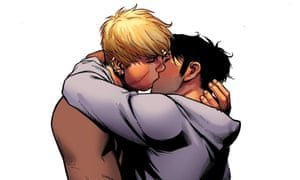Brazil’s Battle Over LGBTQ+ Comics: The Avengers Controversy
In 2019, the Rio de Janeiro Book Biennial (Bienal do Livro) Became the center of a global debate on censorship, homophobia, and representation in media. At the heart of the controversy was Marvel’s Avengers: The Children’s Crusade a comic first published in 2010 that featured a simple yet powerful moment: a kiss between two male superheroes in a committed relationship.
The Mayor’s Ban
Rio’s then-mayor, Marcelo Crivella, ordered that all copies of Avengers: The Children’s Crusade be seized and wrapped in black plastic. His office argued that the action was meant to “protect children” and comply with Brazilian law. Crivella denied that the move was censorship or homophobia, framing it instead as a measure of “decency.” But the decision sparked immediate outrage. To many, it was clear that the ban singled out LGBTQ+ representation, reducing a tender moment between two characters to a political battleground.
A Protest Wrapped in Plastic
In response, Brazilian YouTuber Felipe Neto staged an act of resistance. He purchased thousands of LGBTQ+-themed books and distributed them for free at the book fair each wrapped in black plastic. His message was clear: the “inappropriate” label did not apply to the stories themselves but to the prejudice of those trying to silence them.
Neto’s protest turned into a viral cultural moment, showing how ordinary citizens could push back against attempts to erase queer visibility.
Brazil’s Climate of Homophobia
This incident did not occur in isolation. Brazil has long grappled with homophobia and transphobia, exacerbated under the leadership of President Jair Bolsonaro, who has openly opposed LGBTQ+ rights. For many, Crivella’s attempt to censor the comic reflected a broader political climate that sought to marginalize queer voices.
The Artist Speaks Out
Jim Cheung, the illustrator of Avengers: The Children’s Crusade, responded with empathy and strength. On Instagram, he wrote:
“As an artist, it is my passion to tell stories of great heroism, compassion, and love with as authentic and diverse characters as possible. Characters that depict every walk of life and colour, whether black and white or brown or yellow or green. The LGBTQ community is here to stay, and I have nothing but love and support for those who continue to struggle for their voice to be heard.” Cheung reminded fans that art is meant to unite, not divide, and urged Brazilians to see their nation as one of diversity and inclusion, not censorship and fear.
This controversy was never truly about one comic or a single kiss. It was about who gets to be seen, whose love is validated, and whether young readers are allowed to encounter stories that reflect the full spectrum of human experience. Comics have long reflected society, pushing boundaries and challenging norms. Just as Superman’s son Jon Kent coming out as bisexual in 2021 expanded representation, The Children’s Crusade had already been laying the groundwork over a decade earlier.
When leaders attempt to erase such stories, they send a chilling message: that queer people do not belong in the narratives that shape culture. But every protest, every court ruling, and every artist’s voice pushes back, making it clear that LGBTQ+ characters are not going away.
A Kiss That Changed the Conversation 
What began as an attempt to silence turned into a global spotlight. The kiss between two fictional characters became a symbol of resistance a reminder that representation matters, and that no act of censorship can erase love. In the end, Brazil’s courts, its citizens, and its artists proved that stories of LGBTQ+ love will not be hidden behind black plastic. They will be read, celebrated, and passed on to future generations who deserve to see themselves as heroes too.



